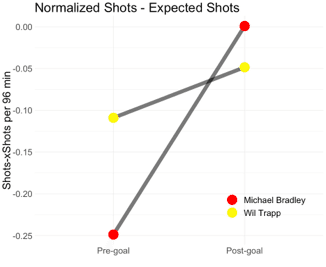
フットボール統計学 ファイナルサードでの意思決定をモデリングする
A TALE OF TWO CENTRAL DEFENSIVE MIDFIELDERS /JANUARY 23, 2019 BY ELIOT MCKINLEY
Note: This work was presented at the OptaPro Soccer Conference in Chicago earlier this January. Full video of our presentation is at the end of this post.
注:この作品は、今年1月上旬にシカゴで開催されたOptaProサッカー会議で発表された。 プレゼンテーションのフルビデオはこの記事の最後にある。
Michael Bradley and Wil Trapp share several obvious qualities. They are both captains for club and country. They are both smooth passing defensive midfielders, and they both possess excellent heads of hair. Another similarity is that they rarely shoot or score goals, each collecting only one goal over the last three seasons. Coincidentally, both of those goals are what we could enthusiastically describe as "wonder-goals." Bradley's long-distance chip for the US national team in a World Cup qualifier against Mexico at the Azteca (a goal not remembered as fondly as it deserves due to the rest of qualifying) and Trapp for the Crew to win a match in stoppage time against Orlando City this past summer. However, one difference between these two players was how each responded to the confidence boost that came after scoring a once-in-a-career goal.
マイケル・ブラッドリー(トロントFC)とウィル・トラップ(コロンバス・クルー)はいくつかの明らかな性質を共有する。 どちらもクラブと国のキャプテンである。 彼らはどちらもスムーズにパスする守備的MFであり、そしてどちらも優れた頭髪を持っている。 もう一つの類似点は彼らが滅多にシュートしたり得点したりせず、それぞれ過去3シーズンで1得点しか決めていない。 偶然にも、これらの得点はどちらも「奇跡の得点」と熱心に説明できるものである。アステカでのメキシコとのワールドカップ予選での米国代表チームのためのブラッドリーの長距離チップ(残りの予選のために値するほどには思い出に残ることはない得点)と、昨年の夏、クルーでトラップがオーランド・シティとの試合で得点した。しかし、これら2人の選手の間の1つの違いは、それぞれがキャリアインゴールを決めた後にもたらされた自信向上にどのように対応したかということだった。
A few weeks before Trapp's "monumental goal of the people, by the people, and for the people of Columbus, Ohio," some fellow American Soccer Analysis contributors and I traveled to Chicago to participate in the inaugural US Soccer Hackathon. Over 24 hours, we developed a framework to model player decision making in the final third. Using a couple of different methods (you can find them on Github), we were able to measure the propensity for a player or team to shoot as well as produce maps of where a pass, shot, or dribble is most likely to occur (check out Andrew Smith's article on Atlanta's ruthless attack).
トラップの「オハイオ州コロンバスの人々の、人々による、人々のための記念碑的な得点」の数週間前に、数名の同僚のAmerican Soccer Analysisの寄稿者と私はシカゴを訪れ、最初のUSサッカーハッカソンに参加した。24時間以上かけて、ファイナルサードで選手の意思決定をモデル化するためのフレームワークを開発した。いくつかの異なる方法を使い(Githubで見つけられる)、パスやシュート、ドリブルが発生する可能性が最も高い場所のマップを作成するだけでなく、選手やチームがシュートする傾向を測定できた(アトランタの冷酷な攻撃に関するAndrew Smith氏の記事)。
Back to Bradley and Trapp. Before scoring his goal at the Azteca, Michael Bradley was overwhelmingly likely to pass the ball almost everywhere in the final third. There was a small area around the top of the 18 where he was slightly more likely to shoot, but the likelihood of a shot was still less than 10%. Trapp's shot map was similar before his own long-range goal, although his small zone of shooting was slightly farther from goal and he was still less likely to shoot from there than Bradley. The differences become much more stark following their respective goals. When Bradley returned to MLS after scoring his goal for the national team, he became about three times more likely to shoot from the top of the box when given the opportunity. Trapp however, hardly changed his patterns at all, nearly always opting to pass in the final third.
ブラッドリーとトラップに戻る。アステカでゴールを決める前は、マイケル・ブラッドリーは圧倒的にファイナルサードでほぼどこにでもボールを渡す可能性が高かった。彼がシュートする可能性がわずかに高い領域がゾーン18の上にあったが、しかしシュートの可能性はまだ10%未満だった。トラップのシュートマップは自身の長距離ゴールの前と似ていたが、彼の小さいシュートゾーンはゴールからわずかに遠く離れており、そして彼はそこからブラッドリーよりも撃っていなかった。その違いは、それぞれの得点に沿ってはるかに顕著になる。ナショナルチームでゴールを決めた後、ブラッドリーがMLSに戻ったとき、彼は機会が与えられたときにボックスの上部からシュートする可能性が約3倍になった。しかしトラップは彼のパターンをほとんど変更せず、ほぼ常にファイナルサードでパスすることを選択した。
This tendency becomes even more apparent when subtracting the players' post-goal maps from their pre-goal maps. Bradley's increased shooting stands out as a bright red dot, while Trapp's changes are minimal and diffused around the final third. Finally, using our expected shot model, we can see that Bradley, a player that took around 0.25 shots per game less than expected, became a player that shot around league average. This increase was equivalent to Bradley taking an extra shot every four games. Trapp, however, barely changed his behaviors, taking only an additional shot every 20 games.
この傾向は、選手の得点前マップから得点後マップを差し引くとさらに明白になる。ブラッドリーのシュートの増加は鮮やかな赤い点として際立っているが、トラップの変化はごくわずかで、ファイナルサード近くに拡散している。最後にxShotモデルを使用して、期待値よりも1試合あたり約0.25本少ない選手だったブラッドリーが、リーグ平均の選手になったことがわかる。この増加は、ブラッドリーが4試合ごとに1本多くシュートを撃つのと同じである。しかしトラップは、20試合ごとに1本多くシュートを打つだけで、彼の行動をほとんど変えなかった。


In combination, these two methods can help describe what decisions players make when entering the final third and how those decisions may change over time. In this case, Michael Bradley became more likely to shoot after scoring a wonder goal, while Wil Trapp did not.
組み合わせて、これら2つの方法は、ファイナルサードで選手がどのような意思決定をするか、およびそれらの決定が時間の経過とともにどのように変化するかを説明するのに役立つ。この場合、マイケル・ブラッドリーは奇跡のゴールを決めた後にシュートの可能性が高くなったが、ウィル・トラップはそうしなかった。
It is not difficult to imagine that following a long-range goal, a player may gain the confidence to try it again. While this may be seen this as a weakness, it is not necessarily so. Before his goal, Bradley was a lower likelihood shooter in the final third, and even when he increased his shooting it was only up to the expected level league wide. Perhaps Bradley should have been shooting more from long range when given the option, and scoring his goal at the Azteca gave him the confidence to do so. Trapp did not see a significant increase in shooting propensity, although he was also already close to the league average. Trapp also had a very defined role in Gregg Berhalter's system in Columbus, which did not include shooting from long range.
長距離ゴール後で、選手がそれを再試行する自信を得られると想像するのは難しくない。これは弱点と見なされるかもしれないが、必ずしもそうではない。ゴールの前に、ブラッドリーはファイナルサードで可能性が低いシューターで、そして彼がシュートを増やしたときでさえ、それはリーグの期待値までしかなかった。恐らくブラッドリーは長距離からの選択肢を与えられたときにもっと多くを撃っているはずだったし、アステカでゴールを決めたことはそうする自信を与えた。トラップはシュート傾向の大幅な増加は見られなかったが、すでにリーグ平均に近いものだった。トラップはまた、コロンブスの指揮官グレッグ・バーホルターのシステムで非常に明確な役割を果たしており、これには長距離シュートは含まれていなかった。
Metrics such as these can give insights into player behavior which could find potential use in several ways. An obvious example is opposition scouting. Knowing where a player is likely to shoot or pass, allows a team to plan for these events. Additionally, if a player is making decisions that a manager may want to change, these maps can bring those anomalies to light.
これらのような測定基準は、いくつかの方法で潜在的な用途を見つけることができる選手の行動への洞察を与えることができる。明白な例はスカウティングである。選手がどこでシュートしたりパスしたりする可能性があるかを知っていると、チームはこれらのイベントを計画することができる。さらに、もし指揮官が変えたいと思っているような意思決定を選手が行っている場合、これらのマップはそれらの異常を明るみに出すことができる。
Watch the video of our presentation below to see a few more examples of the potential uses of decision making models in the final third.
下のプレゼンテーションのビデオを見て、ファイナルサードの意思決定モデルの潜在的な使用例をいくつかご覧ください。
ここから先は
¥ 100
この記事が参加している募集
#フットボール統計学
